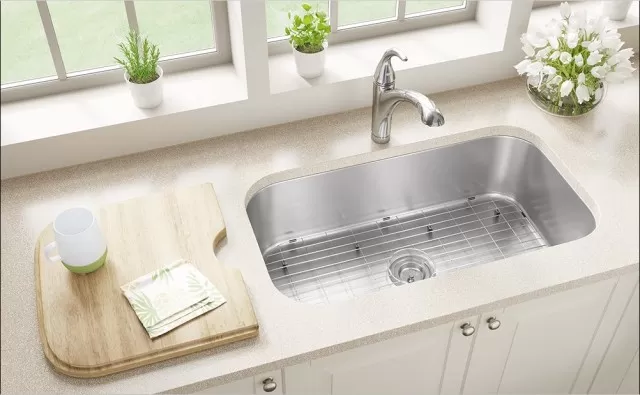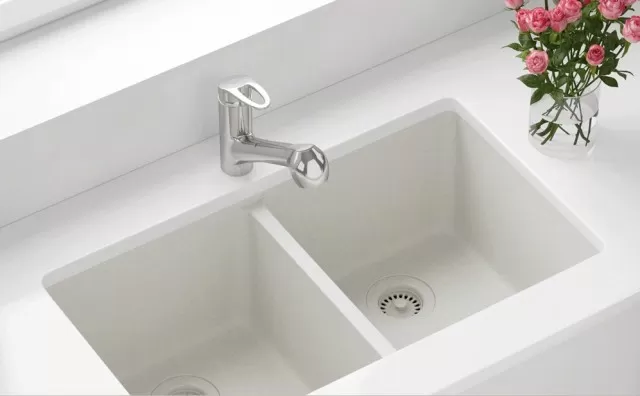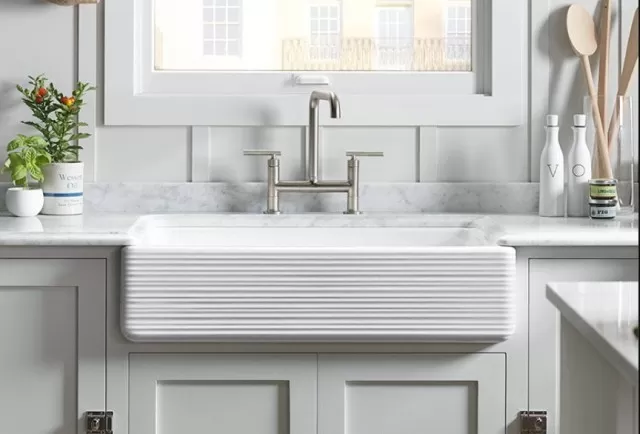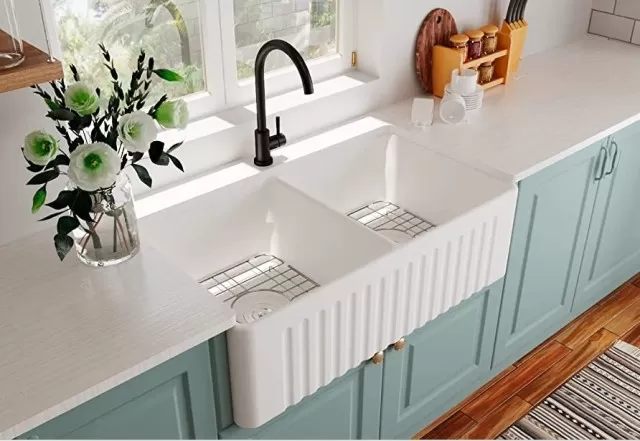With our busy schedules and tempting distractions, it’s understandable that dishes can pile up and leftover food scraps get neglected in the kitchen sink.
However, it’s important to recognize that the kitchen sink endures a lot of use throughout the week, accumulating grime from pots and pans and even soil from watering houseplants.
Unfortunately, it doesn’t always smell fresh and pleasant in the vicinity of the dish disposal. The natural buildup of old food and dirt can persist in your kitchen sink and drain, spreading unpleasant odors throughout your home if not addressed regularly and properly.
To keep your kitchen sink and drain in good shape, it’s crucial to clean them regularly. Make it a habit by adding this task to your weekly cleaning routine and show some love to your kitchen sink and drain.
Stainless-Steel Kitchen Sink

Apply Cleaner and Scrub.
Start by wetting the sink and coating it with baking soda.
Then, add a small amount of Dish Soap to a sponge and create a soapy solution. Use the sponge to scrub the sink, starting from the sides of the basin and working your way down.
Pay attention to any areas with grime or stains, and make sure to push the dirt and debris directly into the drain. Add more soap and water as needed until the surface is free of scum and grime.
Rinse and Dry.
Once you have thoroughly scrubbed the sink, rinse it with Clean Water to remove any remaining residue.
Stainless steel is prone to water spots, so it’s essential to dry the sink thoroughly. Use a plush microfiber cloth to wipe and buff the sink, ensuring it is completely dry and free from streaks or water spots.
By following these steps, you can effectively clean and maintain the shine of your stainless-steel kitchen sink, keeping it free from stains and looking its best.
Remember to avoid using acidic foods or bleach-based sprays that can damage the finish of the stainless steel.
White Kitchen Sink

Apply Cleaner and Scrub.
Start by dampening a cloth with water and patting it over the entire sink surface to make it slightly damp.
Sprinkle baking soda generously over the sink basin, ensuring that it covers the stained areas completely. Then, add a few drops of hydrogen peroxide over the baking soda to create a paste.
Use a sponge or brush to scrub the sink, focusing on the stains and discolored areas. The baking soda and hydrogen peroxide will work together to lift and remove stains.
Drain and Dry.
After scrubbing the sink thoroughly, rinse the mixture down the drain using warm water.
Use a soft cloth to dry the sink, ensuring that it is completely dry to prevent any water spots or streaks.
Following these steps will help you clean your white kitchen sink effectively, removing rust, food splatters, and stains, and restoring its original appearance.
Porcelain Kitchen Sink

Treat Rust Stains.
To remove rust stains from a porcelain sink, you can use a combination of salt and lemon.
Sprinkle some salt on a lemon half and use it to scrub the rusted areas of the sink. The salt and lemon work together to break down and remove the rust stains.
Rinse and Dry.
After treating the rust stains, rinse the sink thoroughly with warm water to remove any residue.
Then, wash the entire sink with warm, soapy water. Use a sponge or a soft cloth to gently clean the surface of the sink.
Finally, rinse the sink again and dry it thoroughly with a microfiber cloth or a towel.
By following these steps, you can effectively clean a porcelain kitchen sink, including treating rust stains and preserving its glossy finish.
Kitchen Faucets and Handles

Use Soapy Water.
Prepare a mixture of warm water and dish soap.
Dip a sponge or a brush into the soapy water and use it to wipe down the faucets and handles. Ensure you cover all surfaces thoroughly.
Reach Hard-to-Reach Areas.
For areas that are difficult to clean, such as crevices and tight spaces, use a toothbrush.
The bristles of the toothbrush can effectively reach these areas and remove any grime or dirt.
Address Lime Buildup.
If you notice white spots on the faucets and handles after cleaning, it may be due to lime buildup from minerals in your tap water.
To tackle this issue, add a spoonful of vinegar to the soapy water mixture and give the faucets and handles a final scrub. The acidity of the vinegar helps break down the lime buildup and leaves the surfaces clean and shiny.
By following these steps, you can effectively clean your kitchen faucets and handles.
Kitchen Drain

Pour the Mixture Down the Drain.
Follow the 1:2 ratio by using one part baking soda and two parts white vinegar.
Start by pouring the baking soda down the drain, and then slowly add the white vinegar. Allow the mixture to sit for about 15 minutes, during which it will create a bubbling reaction.
Add Boiling Water.
After the 15-minute wait, flush the drain with boiling water.
This step will help remove any remaining residue and ensure a clean drain.
By following these steps, you can easily clean your kitchen drain using baking soda and vinegar.
*The information is for reference only.